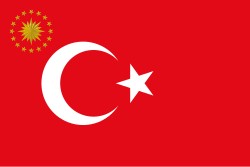This article needs additional citations for verification .(April 2024) |
This is a list of flags used historically and currently by the state of Turkey and its predecessor states. For a list of flags related to the Ottoman Empire, see Flags of the Ottoman Empire.
Contents
- National flags
- Military flags
- Land Forces
- Naval Forces
- Air Force
- Gendarmerie General Command
- Coast Guard Command
- Other
- References
Wikimedia Commons has media related to Flags of Turkey .



































